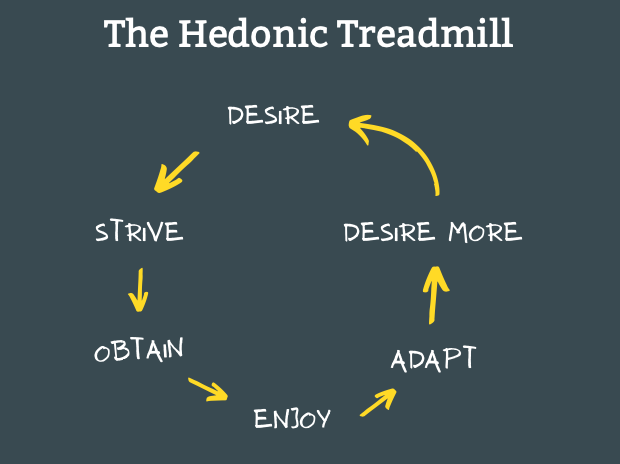Want True Happiness? Stop Chasing Sensory Pleasures

Another Friday night. I am out to have drinks with friends after work. We are trying a new bar that opened recently and got famous with interesting artisan cocktails. Everything seems nice, except I can’t find the cocktails any interesting. Neither taste nor presentation is not very different from the place we have been to last week.
Going out with friends is a usual Friday activity for many of us. Trying new places to seek (not necessarily have) fun. Drinking, having some food, and talking about the same topics a thousand times. The situation gets worse if it is a date night. Then we again have to tell the classic date night story; where we live, where we are from, where we are working, etc.
People, places, foods, and drinks might slightly change each time, but the feeling is always that same stale taste.
If we could travel abroad like we used to do before COVID days, we could get refreshed, reset, and not realize that we keep doing similar things to entertain ourselves. Seeing a different country, spending some time in an unfamiliar environment, and meeting new people would hide the fact that our happiness is tied to sensory pleasures, preferably novel ones.
Is this all we have in life? — sensory pleasures. If so, many of us can die in peace around our early 30s. Taking it to start from the 20s, a decade of having sensory pleasures would be more than enough.
When we are young, elevating ourselves to mental states such as ecstasy, euphoria, and flow derived from external stimulation is easy. This is because the world is undiscovered and attractive. Here the external stimulation refers to food, drinks, a promotion at work, buying a nice car, finding a partner you get along with, and so on. But when we get older, we also get desensitized, and despite the quality of external stimulation increases, it is much harder to reach those euphoric mental states.
Nonetheless, either bodily or not, we all want those ecstatic mental states throughout our lives. Hedonism, in simple terms, pleasure-seeking and pain avoidance is in our very nature. But if external stimulation is no longer sufficient for hedonistic fulfillment, then how to find happiness?
Ever since bodily pleasures were no longer bringing me to those states, I was in search of a higher pleasure beyond sensory ones. I soon discovered a different type of pleasure comes from cognitive effort, enhanced thoughts, and spiritual seeking. I will explain what I found and how I got there in 3 parts: Hedonic Treadmill, Hedonic Set Point, Escaping the Treadmill
Hedonic Treadmill
Coined by Philip Brickman and Donald T. Campbell in 1971, hedonic treadmill, or in other words hedonic adaptation, is the human tendency to return to a set level of happiness despite life’s ups and downs. For instance, you dream about a big house, work hard, make more money, and move that house. You feel amazing for some time, but sooner or later, you dream about another larger house. So practically, you are stuck in a vicious cycle because of your desires. Here is the illustration of that cycle:

According to Hedonic Treadmill theory, expectations are always higher compared to what you already have. The human tendency is to desire more. Thus, regardless of how much you have, you are bound to return a set level of happiness.
Hedonic Set Point
A hedonic set point is the set level of happiness you always end up returning. Let’s assume your hedonic set point is 70 out of 100. When you move that big house, your happiness hits somewhere around 90–100 points. However, as days pass, you will end up returning to the baseline of 70 points.
In this theory, happiness is heavily affected by external stimulation. And newer stimuli are a bigger source of joy. The problem is you cover most of the stimuli available in the world by the 30s. So it gets harder to find novel things because of past experiences. Imagine how excited you were on your first night out of your life vs. years after partying million times.
Sounds terrific right? We are all doomed to boring Friday drinks talking not-so-exciting topics. No, no, kidding. There is an escape.
Escaping the Treadmill
According to a study by Barbara Fredrickson, meditation can outpace the effects of the hedonic treadmill. Regular meditation practice produces increased mindfulness, life satisfaction, and positive emotions like happiness.
Aha! Happiness is possible without any external stimulation.
We can produce inner joy by simply sitting down and spending a couple of minutes in the present moment — hearing a soft wind, noticing the temperature of air against our skin, feeling the weight of our bodies on the earth, and taking a few deep breaths. That’s all we need to feel good.
Being present in the moment and noticing its beauty brings gratification for simple things we take for granted. Instead of abusing all the wonders, we can show our thankfulness with a short meditation session every day. Offering gratitude to our surroundings, and thank them for supporting us all of life.
Gratification, the highest of the earthly pleasures, will elevate us to those ecstatic mental states just as sensory pleasures do. If the mind is ripe enough, the euphoria of gratification can outweigh the feeling of superficial sensory pleasures. The reason is gratification stems from our boundless inside world, whereas sensory pleasures cannot go beyond limited outside world offerings.
Final Thoughts
A permanent state of happiness exists and is reachable when we can see what awaits beyond sensory pleasures. Although we need stable finances for our primary needs, we should not focus on accumulating wealth as means to increase the overall level of happiness.
Lifelong bliss is a matter of a mindset switch. True happiness is readily available in all of us. It is for us to bring out what is already there. Gratification is key; mindfulness meditation greatly helps.